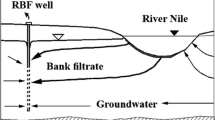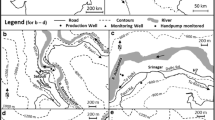Abstract
Riverbank filtration (RBF) is an efficient and low-cost natural alternative technology for water supply application in which surface water contaminants are removed or degraded as the infiltrating water moves from the river/lake to the pumping wells. The removal or degradation of contaminants is a combination of physicochemical and biological processes. For more than 100 years, RBF has been used in Europe for public and industrial water supply along Rhine, Elbe, and Danube rivers. This paper presents an investigation of a full-scale RBF plant located in Upper Egypt as section of Nile valley to produce drinking water. The studied plant is constructed in 2004 to supply potable water for Sidfa city (30,000 residents), Assiut Governorate. It consists of 6 vertical wells, each about 60 m deep, with distance about 30 m from the west bank of Nile. Water samples from Nile as induced surface water, from background groundwater, and from production wellfield were collected and analyzed at three discrete events. Quality measurements of physical, chemical, and microbiological characteristics were obtained. Comparison of produced water with surface and background natural groundwater for the investigated plant has proven the effectiveness of RBF technique for potable water supply in Upper Egypt. Physicochemical and microbiological characteristics of the produced water are better than the allowable standards for drinking purposes. The results prove the implementation of RBF treatment method for water supply in Nile valley.



Similar content being viewed by others
References
Abdel-Lah A, Shamrukh M (2006) Riverbank filtration: a promise method for mater supply from Nile, Egypt. In: Proceedings of 7th international symposium on water supply technology, Yokohama, 385–395
Abdel-Lah A, Shamrukh M, Shehata A (2002) Efficiency of iron and manganese removal from groundwater using aeration tower in Nile valley, Egypt. In: Proceedings of 3rd international symposium on environmental hydrology. American Society of Civil Engineers-Egypt Section (ASCE-EGS), Cairo
APHA, AWWA, WEF (1998) Standard methods for the examination of water and wastewater, 20th edn. American Public Health Association, Washington, DC
Attia FA (1989) Groundwater quality in the Nile aquifer system and desert fringes in Egypt. Groundwat Qual AGID spec publ 17:123–129
Brauch HJ, Kuhn W (1986) Behavior of organic micropollutants during riverbank filtration and drinking water treatment. CEE Water Pollution Research Report, EUR 11094
Davis SN, Whittemore DO, Fabryka-Martin J (1998) Uses of chloride/bromide ratios in studies of potable water. Ground Water 36:338–350
Dekov VM, Komy Z, Araujo F, VanPut A, Van Grieken R (1997) Chemical composition of sediments, suspended matter, river water and groundwater of the Nile ( Aswan-Sohag traverse). Sci Total Environ 201:195–210
Dillon PJ, Rhebergen W, Miller M, Fallowfield H (2000) Groundwater: past achievements and future challenges. In: Sililo et al (eds) Balkema, Rotterdam
Donald D, Grygaski T (2002) Development of a sustainable potable water supply for rural villages in the coastal region of Tanzania, Africa. ENVE 431 Final Project Report, University of Waterloo, Ontario
Doussan C, Poitevin G, Ledoux E, Detay M (1997) Riverbank filtration: modeling of the changes in water chemistry with emphasis on nitrogen species. J Contam Hydrol 25:129–156
Hach Company (1998) DR-2000 users manual. Hach Company, Ohio
Hiscock K M, Grischek T (2002) Attenuation of groundwater pollution by bank filtration. J Hydrol 266:139–144
Irmscher R, Teermann I (2002) Riverbank filtration for drinking water supply- a proven method, perfect to face today’s challenges. Water Sci Technol Water Supply 2(5–6):1–8
Ismail SS, Ramadan A (1995) Characterization of Nile and drinking water quality by chemical and cluster analysis. Sci Total Environ 173/174:69–81
Jüttner F (1999) Efficacy of bank filtration for the removal of fragrance compounds and aromatic hydrocarbons. Water Sci Technol 40(6):123–128
Kuehn W, Mueller U (2000) Riverbank filtration: an overview. J Am Water Works Assoc 92(12):60–69
Ray C (2001) Riverbank filtration: an analysis of parameters for optimal performance. In: AWWA Annual Conference, Washington DC
Ray C (2004) Modeling RBF efficacy for mitigating chemical shock loads. J AWWA 96(5):114–128
Ray C, Melin G, Linsky R (eds) (2002) Riverbank filtration: improving source water quality. Kluwer Academic Publishers, Dordrecht
RIGW (1991) Hydrogeological map of Egypt: Tahta region (1:100,000). Research Institute for Groundwater (RIGW), Water Research Center, Ministry of Public Works and Water Resources, Egypt
Schijven J, Berger P, Miettinen I (2002) Removal of pathogens, surrogates, indicators, and toxins using riverbank filtration. In: Ray C, Melin G, Linsky RB (eds) Riverbank filtration: improving source water quality. Kluwer Academic Publishers, Dordrecht, pp 73–116
Schubert J (2002) Water quality improvements with riverbank filtration at Düsseldorf waterworks in Germany. In: Ray C, Melin G, Linsky RB (eds) Riverbank filtration: improving source water quality. Kluwer Academic Publishers, Dordrecht, pp 267–280
Shamrukh M, Abdel-Lah A (2004) Monitoring of agricultural nutrients in water supply wells, Upper Egypt. J Eng Appl Sci Cairo Univ 51(6):1135–1150
Shamrukh M, Corapcioglu MY, Hassona FAA (2001) Modeling the effect of chemical fertilizers on ground water quality in the Nile valley aquifer, Egypt. Ground Water 39(1):59–68
Sontheimer H (1980) Experience with riverbank filtration along the Rhine river. J AWWA 72:386–390
Weiss WJ, Bouwer EJ, Ball WP, O’Melia CR, Aurora H, Speth TF (2002) Reduction in disinfection byproduct precursors and pathogens during riverbank filtration at three midwestern United States drinking-water utilities. In: Ray C, Melin G, Linsky RB (eds) Riverbank filtration: improving source water quality. Kluwer Academic Publishers, Dordrecht, pp 147–174
World Health Organization (2005) Guidelines for drinking-water quality. 2nd edn, vol 1. Recommendations
Acknowledgments
The authors are grateful to Engineers of New Nagh-Hammadi Barrage, to the operators of Sidfa RBF Plant, and to the staff of Ministry of Health and Population in Egypt (Assiut Branch).
Author information
Authors and Affiliations
Corresponding author
Rights and permissions
About this article
Cite this article
Shamrukh, M., Abdel-Wahab, A. Riverbank filtration for sustainable water supply: application to a large-scale facility on the Nile River. Clean Techn Environ Policy 10, 351–358 (2008). https://doi.org/10.1007/s10098-007-0143-2
Received:
Accepted:
Published:
Issue Date:
DOI: https://doi.org/10.1007/s10098-007-0143-2




